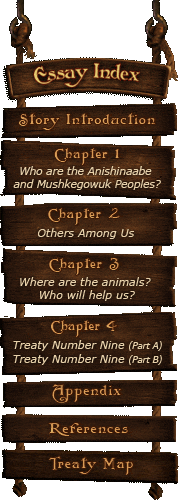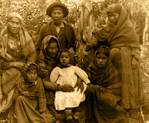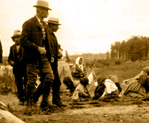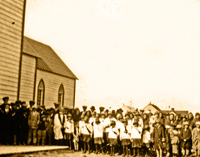
Where are the animals? Who will help us?
As I mentioned earlier, since 1670, our peoples began a 300-year economic relationship with the Hudson's Bay Company fur trade in the James Bay region. We became the experts who lived deep inland during the winter months, trapped and brought in many beaver pelts to the coastal posts during the summers. At first life was good for our peoples as trappers saw the rewards of their labours and the new technology offered by the Europeans. Instead of bow and arrows we now traded for steel guns. Instead of wooden deadfall traps, we now acquired steel traps. We also traded our furs for steel pots, pans, knives, axes and other utensils. We even watched the Europeans dance to fiddle tunes and we liked it so much that we learned their dances and songs on fiddles of our own. We even incorporated foods of the Europeans like bannock, tea, sugar and lard into our traditional diets.
But somewhere along the way, this all changed and it was in the years 1850 to the early 1900s. Although peoples had experienced sickness before, in this time period our peoples again became infected with European diseases like whooping cough, measles and influenza. It was hard when people got sick because many of them were far from the settlements where medicine and skilled medical assistants might help them.
"One time there was a family who lived in a tent when it was very cold. The parents died and only the children survived. That was when there was a great sickness. Both the parents died, both the father and the mother. One child died as well. Only a girl, a boy, and a baby survived. They were far from the reserve. They took the baby and started to walk. We do not know how many days and nights they walked. All of them managed to get to the settlement. Those children whose parents died were very poor" (Elder Gabriel Kam in Ojibway Cree Cultural Centre 1999: 25-26).
Many of our people also had a lot of trouble finding animals to trap and hunt for food. Something was happening on the land with the animal populations that made finding them extremely difficult. Often they could only find small game like rabbits, ptarmingan and fish. So many people died of starvation. Our Elders tell many stories of hunting hardships and of those who perished from hunger. My own mother who was a young child in the early 1900s told me that often the only food they could depend on was fish. She ate fish everyday with small portions of bannock and tea.
My mother's family (five siblings) often didn't eat until her mother could check the nets in the morning. My mother says that people today do not understand the difficult times she and others went through (Elder Agnes Louttit 2008: personal communication). You will see what I mean by reading the following Elder narratives:
"I saw the people of one family starve to death. We were not living very far away. They did not have anything to eat while they were traveling. Five of them froze to death on their return because they collapsed due to hunger. One woman had a child she was carrying in a tikinagan. That child died because the mother could not produce milk due to a lack of food" (Elder Juilette Sutherland in OJCC 1999:68).
"They traveled two days without having anything to eat. They were almost near the village when his stepson told him that the family could not travel any further. It was very cold. According to the old man, they immediately tried to go ashore. He said the younger woman was the first to collapse. Some died in that shelter as night was approaching" (Elder Nancy Patrick in Ojibway Cree Cultural Centre 1999: 40).
"That is how poor we were during our childhood. We almost starved then. We could not even catch fish in the net. We had nothing to live on when we were camping there. All we did was fish for pike. That is what we ate" (Elder Ellen Sainnawap in Ojibway Cree Cultural Centre 1999: 9)."When I was young, I saw many people who had nothing to eat. Once, two starving adults and two starving children were brought to the place where we were living. Two other children from that family had died earlier. This hungry family survived by eating small fish that surfaced on a little creek. This family stayed with us for about one week" (Elder Agnes Nakogee in Ojibway Cree Cultural Centre 1999: 31-32).
There are many other narratives about sickness, starvation and poverty but the ones I've shown you I think are sufficient. My point is that I would like you to know that by the beginning of the 20th century many of the people were poor, starving and ill from sickness. And in this condition many of our people were destitute and distressed about what would happen to them and their children. They despaired over why the animals had seemingly abandoned them.
As well, many people lost faith in our ways and set aside their traditional beliefs for the Christian faith.
It was at this time that many people heard stories of other peoples to the south who were signing treaties for money, medicine, schools and relief as a means to help them survive.
Our Elders, parents and village leaders were thinking of the future for their communities, families and children.
What would they have? What could they do now to improve their situation? So it was in this way that our peoples sought to make a treaty with the governments of the day.











